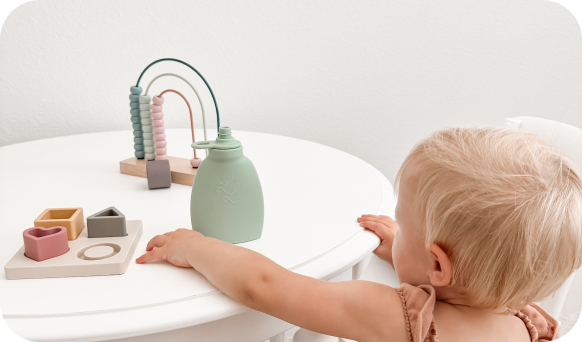Starting Right: When Should Babies Begin Eating Baby Food?

Are you wondering if it's time for your baby to start exploring the world of solid foods? Every parent has been there—excited but also a little anxious about making sure everything goes smoothly.
Introducing solids to your baby is an exciting adventure filled with new tastes and experiences. It's also a key moment in developing healthy eating patterns for life.
But when is it time to start baby food? What signs should you look for to know your baby is ready? And what are the best first foods to offer?
Essential Takeaways:
- Your baby might be ready for solid foods if they show signs like steady head control, interest in your meals, mimicking eating motions, and opening their mouth for food. Start them off right with homemade purees, mashes, and smoothies. By preparing these foods at home, you have complete control over the ingredients, ensuring your baby gets the healthiest start without any added preservatives or sugars.
- It’s important to know the right way to feed your baby. We have found high quality reusable baby food pouches allow for a mess-free, convenient feeding experience. Using a refillable baby food pouch makes it easy to offer your baby a variety of nutritious, homemade foods in a safe, enjoyable way, fostering positive early food experiences and paving the way for healthy eating habits.
This guide will help you navigate these questions with practical tips for a seamless shift from milk alone to their first solid bites.
- Introducing Solids: Understanding the Journey
- The General Timeline: Expert Recommendations
- First Foods: What to Start With
- Safety First: Precautions and Tips
- The Role of Breastmilk or Formula
- Listening to Your Baby: Hunger and Fullness Cues
- Introducing The Palmetto Pouch: Simplifying Baby’s First Foods
- Wrapping Up Your Baby's Introduction to Solids
Introducing Solids: Understanding the Journey
Starting your baby on solid foods is not an exact science. It varies from one baby to another with each child setting their own pace. Some babies might be ready to try solid foods earlier, while others might need a little more time.
First Foods: Purees, Mashes, and Smoothies
As your little one begins this new chapter in their development, purees, mashes, and smoothies play an important role. These softer options ease the transition from milk to more complex foods, introducing an array of flavors and textures. They're also excellent for ensuring your baby gets a variety of nutrients. For instance, iron-fortified purees are a popular first choice among health professionals.
For delicious and baby-friendly recipes to start this journey, check out our collection of Easy Baby Food Recipes for Busy Moms, perfect for your little one’s introduction to solids.
Feeding as a Journey of Discovery
Keep in mind that every parent's feeding journey is unique, just like their child. What works for one family may not work for another. As you transition your child to solid foods, it’s essential to be patient, attentive, and flexible. After all, feeding is not just about nourishment, it’s also about discovery and bonding as a family.

The General Timeline: Expert Recommendations
Pediatricians commonly recommend starting the introduction of solid foods around the 6-month mark, aligning with the average developmental readiness and nutritional needs of infants at this age. It's also when many babies begin to need additional nutrients, such as iron, that breastmilk or formula alone may no longer sufficiently provide.
Key indicators that your baby may be ready to start solids include:
- Being able to hold their head up steadily without support.
- Showing interest in your food during meal times.
- Mimicking eating motions.
- Opening their mouth when food approaches (1).
Each baby will exhibit these signs on their own timeline, and some may display readiness slightly earlier or later than the six-month guideline. If you're uncertain or if your baby has specific health considerations, it's always best to seek personalized advice from your pediatrician.
First Foods: What to Start With
Exploring solid foods with your baby is an exciting time! Starting with easy-to-digest, smooth-textured foods can set the stage for a positive experience. Rice cereal is a favorite initial choice due to its minimal allergy risk and gentle nature on a baby’s developing digestive system (1).
Pureed vegetables like sweet potatoes and carrots are also excellent starter foods packed with essential nutrients and a natural sweetness that babies often enjoy (1).
Here are some tips to make this process as easy as possible:
-
Introduce Gradually:
Begin with one single-ingredient food and stick with it for several days. This practice helps you monitor your baby's reaction to each new food (1).
-
Allergy Awareness:
Watch for any signs of allergies, such as rash, hives, or digestive upset. Introducing foods one at a time makes it easier to identify the culprit if an allergic reaction does occur (1).
-
Mix and Match:
Once you've safely introduced a few single foods, you can start combining them to enhance flavor and nutrition (2).
Remember, patience is key. Each baby will respond differently to new tastes and textures. Follow your baby's cues and allow their appetite and curiosity to set the pace for this delicious new chapter.
Safety First: Precautions and Tips

As you and your little one navigate the exciting world of solid foods, you’ll want to keep safety in mind. Here are some important guidelines to help make mealtime a secure and enjoyable experience:
-
Mind the Size:
Cut foods into small, manageable pieces to reduce the risk of choking. It's critical to adapt the size and texture to your baby's chewing and swallowing abilities.
-
Cook to Perfection:
Ensure all foods are cooked to the right softness—firm enough to hold but soft enough to mash with gentle pressure. Remember to let food cool down to a temperature that won't harm your baby's sensitive mouth.
-
Supervise Closely:
Always stay with your baby while they eat to keep them safe. You can also use this time to bond and learn about your baby’s likes and dislikes.
-
Hold Off on Honey:
Honey may be nature’s sweetener, but it's off-limits for babies under one year due to the risk of infant botulism, a serious condition caused by bacteria found in honey (3).
-
Use Safe Feeding Tools:
The Palmetto Pouch offers a safe and convenient feeding solution with its innovative spoon-lid combo and soft silicone spout. These features not only make mealtime less messy but also ensure a gentle and safe feeding experience for your baby. Perfect for on the go and at-home use, The Palmetto Pouch minimizes choking risks while encouraging self-feeding under supervision.
Nurturing your baby’s palate is a wonderful journey filled with messy faces and new discoveries. By keeping these precautions in mind, you'll create a safe environment that allows your baby to explore new tastes and textures with confidence.
The Role of Breastmilk or Formula
While introducing solid foods is an important milestone in your baby’s first year, breastmilk or formula should still be their main source of nutrition. These should not be quickly replaced by solid foods but rather complemented by them.
Introduce Solids Gradually
It’s important to continue regular milk feedings and introduce solids slowly. Your baby’s appetite will naturally adjust the balance between milk and solid intake over time.
Keep offering milk as the core part of your baby’s diet throughout the first year and introduce solids as a supplement, gradually increasing as your baby shows more interest and ability to eat them (4).

Listening to Your Baby: Hunger and Fullness Cues
Understanding your baby’s hunger and fullness cues is key to a positive feeding experience. Hunger cues may include behaviors like opening their mouth, reaching for food, or showing excitement when they see food. In contrast, fullness is often indicated by turning away from food or losing interest in eating.
Respecting Fullness Cues
It’s important to respect these signals and not push your baby to eat more food once they indicate they’re full. This helps to foster healthy eating habits and ensures your baby is comfortable (4).
Exploring Baby-Led Weaning
The baby-led weaning method offers an alternative to traditional weaning with spoon-feeding. In baby-led weaning, babies are encouraged to self-feed with finger foods, allowing them to eat at their own pace and become familiar with different textures. This approach promotes independence and can help babies tune in to their hunger and fullness cues, as they are more in control of their eating (5).
Introducing The Palmetto Pouch: Simplifying Baby’s First Foods
As you embark on the exciting journey of introducing solids to your little one, The Palmetto Pouch from Lowcountry Littles emerges as an indispensable ally. This isn’t just another snack pouch. It’s an innovative solution designed for the new-age parent who values both convenience and environmental consciousness.
Why Choose The Palmetto Pouch?
Eco-Conscious and Convenient: Our pouches are thoughtfully designed to be reusable and easy to clean, aligning with your commitment to reducing waste and respecting our planet. By choosing The Palmetto Pouch, you’re making an eco-friendly choice for your family and the earth.
Perfect for Transitioning to Solids
Tailored for babies starting on solid foods, these pouches are ideal for serving purees, smoothies, yogurt, and other nutritious homemade meals. They simplify the feeding process, making it a hassle-free and enjoyable experience for both you and your baby.
Innovative Spoon-Lid Combo
A pioneering feature in the baby feeding market, our unique spoon-lid combo offers unparalleled convenience, especially for feeding on the go. This feature is currently under patent review, highlighting its uniqueness in the market.
Gentle Soft Silicone Spout
Designed with your baby’s comfort in mind, the soft silicone spout is gentle on developing gums, ensuring a safe and pleasant feeding experience.
Variable Flow Opening
Our pouches come with a variable flow opening, minimizing spills and leaks and giving both parents and children more control during feeding times.
The Palmetto Pouch is more than just a feeding tool. It’s a symbol of thoughtful parenting, embodying innovation, safety, and environmental responsibility. It sets a new standard in baby feeding solutions, making every mealtime a seamless and enjoyable experience for you and your little one.
Wrapping Up Your Baby's Introduction to Solids
Remember, introducing your baby to solid foods is about much more than nutrition. It’s a journey of discovery, bonding, and joy. With The Palmetto Pouch by your side, this journey becomes even more delightful.
Are you ready to experience the benefits of The Palmetto Pouch for yourself? Shop now, and transform mealtime for you and your baby.
References:
- Centers for Disease Control and Prevention. (2023). When, What, and How to Introduce Solid Foods. Retrieved from https://www.cdc.gov/nutrition/infantandtoddlernutrition/foods-and-drinks/when-to-introduce-solid-foods.html
- Care.com. (2023). Stage 2 Baby Food: How to Know When to Offer a Bit More Texture. Retrieved from https://www.care.com/c/ready-for-stage-2-baby-food/
- WebMD. (2023). When Can a Baby Have Honey? Retrieved from https://www.webmd.com/baby/when-can-a-baby-have-honey
- Mayo Clinic. (2021). Solid Foods: How to Get Your Baby Started. Retrieved from https://www.mayoclinic.org/healthy-lifestyle/infant-and-toddler-health/in-depth/healthy-baby/art-20046200
- Cameron, S. L., Heath, A. L., & Taylor, R. W. (2012). How Feasible is Baby-Led Weaning as an Approach to Infant Feeding? A Review of the Evidence. Nutrients, 4(11), 1575–1609. Retrieved from https://www.ncbi.nlm.nih.gov/pmc/articles/PMC3509508/
